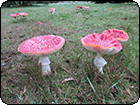Rice. In terms of Indian home food you either eat rice or you eat something with
chapati pretty much. And I'm not that into the latter; I like foods you can eat with a spoon or in a wrap. So I eat a lot of rice.
→[More:]
It's also like comfort food for me, especially when I'm working late at night as is my schedule.
The problem is that rice puts me to sleep like BAM! As soon as I eat it I get tired/sleepy really quick and that's uncomfortable especially in crunch time when I'm just working straight through the day/night. Also, I've always heard that it's nutritionally not good for you although I don't really know what the science is there--like exactly how many calories are we talking, etc.
I've noticed that there's a preparation we make that closely mimics rice: it's called dalia. I'm not sure what you'd call it in western terms but the syononyms they give it online seem to be 'broken wheat'/'cracked wheat'. Couple pictures:
Cracked Wheat Pulav (Dalia Pulav)
Dalia (Wheat Rava or Cracked Wheat Upma)
As I think/research a bit more on this I'm realizing that there's a LOT to learn about all sorts of flours and grains, derived from various ways of processing various parts of various plants. I first got into thinking about this when thinking about replacing white bread etc. but it's interesting that even more widely speaking you can be replacing certain grains with others.
The other thing I'm realizing though is that--even though I like eating these things--I probably don't even need to have such a carbohydrate heavy diet anyway. So I'm also trying to seague more heavily into just vegetables and protein..
The basic deal is that due to historical, agricultural and industrial factors you end up eating certain sorts of things that are prevalent to cook in your personal context. So you just have to start stepping back and wondering what exactly you want to eat, and how what you eat affects you, then go and find these less common ingredients and make the less common dishes..
 photo by splunge
photo by splunge
 photo by TheophileEscargot
photo by TheophileEscargot
 photo by Kronos_to_Earth
photo by Kronos_to_Earth
 photo by ethylene
photo by ethylene